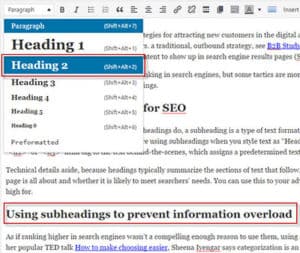One of your most important marketing strategies for attracting new customers in the digital age is to draw prospects to your website with useful content. (If you’re not already familiar with the benefits of an inbound marketing strategy vs. a traditional, outbound strategy, see B2B Study: Marketers Grow Focus on Inbound Marketing in 2017.) Creating relevant and useful information, though, is only the first step. To get your content to show up in search engine results pages (SERPs) where potential customers can find it, you must optimize it for search engines.
There are plenty of ways to improve your ranking in search engines, but some tactics are more effective than others. One content marketing strategy I’ve found particularly useful lately, which I’d like to share with you, is the use of subheadings.
How to use subheadings for SEO
If you’re not already familiar with what subheadings do, a subheading is a type of text formatting commonly used to divide blog and other content into sections for easier reading. In a content management system like WordPress, you are using subheadings when you style text as “Heading 2,” “Heading 3,” and so on. When you apply the style in a visual editor, the system assigns an “<h2>” or “<h3>” html tag to the text behind-the-scenes, which assigns a predetermined text size and other formatting settings to the text.
Technical details aside, because headings typically summarize the sections of text that follow, Google and other search engines pay close attention to your headings when determining what your page is all about and whether it is likely to meet searchers’ needs. You can use this to your advantage by including headings in your content and filling them with the keywords you’d like to rank high for.
Using subheadings to prevent information overload
As if ranking higher in search engines wasn’t a compelling enough reason to use them, using subheadings is also a great way to prevent readers from becoming overwhelmed with information. In her popular TED talk How to make choosing easier, Sheena Iyengar says categorization is an effective way of avoiding information overload. One study, in fact, found that customers were much less overwhelmed by the number of product choices available when those choices were categorized, even when more choices overall were offered.
Keep this in mind when you craft content for blog posts or other pages on your website. When you break up content with subheadings, you offer a greater level of depth and breadth in your content (which is also good for SEO) without overwhelming website visitors with too much information. They can easily navigate your content and consume it in approachable, bite-sized pieces.
Using subheadings to stay organized
I’ve been incorporating more subheadings into marketing content for my own clients, which has required me to think strategically about the subheadings (and corresponding keywords) I want to use before I sit down and start writing. The unintended but welcome side effect of this technique has been that I consistently have a working outline of my content in place before I begin writing, keeping me organized and ensuring that each section stays on topic.
Need more help organizing and formatting your organization’s website content for SEO and user-friendliness? 3 Aspens Media offers content editing, reorganization and writing services. Visit the About Us page to learn more.


